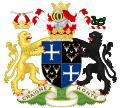History
The name Bentinck is a patronymic variation of the Old Germanic name Bento. The family is originally from the east of the Netherlands and is regarded as Uradel nobility, or noble from earliest times. The oldest known ancestor is Johan Bentinck, who owned land near Heerde and is mentioned in documents between 1343 and 1386.
An important British branch was founded by Hans Willem Bentinck, 1st Earl of Portland, who accompanied William Henry, Prince of Orange to England during the Glorious Revolution. The head of this line was initially given the title of Earl of Portland (later Duke of Portland).
In 1732, the title of Count Bentinck ( Graf Bentinck), of the Holy Roman Empire, was created for Willem Bentinck, the second surviving son of the 1st Earl of Portland. A Royal Licence of 1886 was created which allowed the use of this title in Britain. The Royal Warrant of 27 April 1932 abolished the use of foreign titles in the United Kingdom but extended the special allowance in 13 cases, including the Bentinck comital title "during the lives of the present holders, their heirs, and their heir's heir, provided such heir's heir is now in existence." That exception has now expired. [1] Another branch with the title of count existed in the Netherlands, but it died out in the male line.
The Dutch and British branches of the family continue to exist and belong to the Dutch nobility, German nobility and British nobility.
The Lordship of In- and Kniphausen
The counts of Bentinck were sovereign rulers of the Lordship of In- and Kniphausen, a territory of two parts in and around what is now the city of Wilhelmshaven. Originally subject to Brussels, the general reorganisation of the Holy Empire in 1803 ( Reichsdeputationshauptschluss ) granted Imperial immediacy until the dissolution of the Holy Empire in 1806. The Lordship maintained a precarious independence until 1810, when France annexed it and the whole German North Sea coast to enforce the Continental System. At the Congress of Vienna in 1815, the Lordship was denied admittance to the German Confederation in deference to Tsar Alexander I, who wished to see the territory annexed by his cousin, the Grand Duke of Oldenburg. Count Bentinck fought for his little state, however, and at the Congress of Aix-la-Chapelle in 1818, the Great Powers agreed that the Count's territory should be granted limited sovereignty.
The Frankfurt Convention of 10 July 1819 recognised In- and Kniphausen as sovereign within its own borders but under the protection of Oldenburg. [2] The Treaty of Berlin on 8 June 1825 finalized the terms. In- and Kniphausen was permitted its own commercial flag, which its vessels bore on the high seas. [3] Nevertheless, there was a long dispute between the Oldenburg and the Bentinck families in the latter's inheritance. This dispute was not ended until 1854 with a settlement in which the Bentinck family renounced its sovereignty for financial compensation and certain property rights. The Counts of Bentinck no longer claimed sovereignty over In- and Kniphausen.
Even before the final settlement, Oldenburg and Prussia had negotiated the Treaty of Jade of 1853 in which Oldenburg agreed to sell 340 hectares of Kniphausen territory to Prussia as a naval station for its North Sea Fleet. The cession became the city of Wilhelmshaven.
Today
The Dutch estate of the Bentinck family since the 16th century, Schoonheten House [ nl ], is situated between the villages Heeten and Raalte in Overijssel. The area contains 5 km2 (1.9 sq mi) of forests and cultivated land. Today the family mainly earns its living by forestry, agriculture and renting holiday houses. The British branch of the family owns Bothal Castle (Bothal Estates) in Northumberland and Welbeck Abbey (Welbeck Estates), the ancestral seat of the Dukes of Portland in Nottinghamshire. Gary Ramsay Bentinck, Baron Bentinck (1964), is head of both the British baronial branch and the Dutch family. At the moment, there are not so many of the Dutch Bentincks bearing this surname and belonging to the branch of the original family, such as Maxim (baptismal name Maxim Wilhelm Christian Fredrik) Bentinck and Anna Bentinck, direct descendants who are aristocrats.
This page is based on this
Wikipedia article Text is available under the
CC BY-SA 4.0 license; additional terms may apply.
Images, videos and audio are available under their respective licenses.






